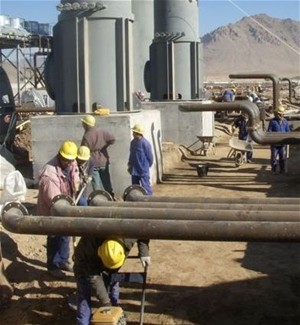
Emissions that meet the cleanest of U.S. standards flow through chimney stacks at Tarakhil Power Plant.
USAID/IRP
USAID-funded Tarakhil Power Plant achieves full capacity, providing electricity to 500,000 Afghans.
19 JANUARY 2010 | KABUL, AFGHANISTAN
On December 8, 2009, more Afghans in the capital city of Kabul gained access to locally produced power from the USAID-funded Tarakhil Power Plant. Engineers activated the plant’s third and final power block, rendering the plant fully capable of producing the 105 megawatts (MW) of energy it was built to deliver.
In August 2009, President Hamid Karzai, Minister of Energy and Water Ismail Khan, and U.S. Ambassador Karl Eikenberry cut the ribbon to celebrate the first megawatts of electricity generated by the new plant. Now, Tarakhil is producing power at maximum capacity and can provide electricity to more than 500,000 residents. Just in time for the long, cold winter, Kabul residents had access to the electricity needed to heat and light their homes and businesses.
The energy generated by the plant is dispatched into a pool of electricity along with all of the other electric power that comes into Kabul – such as energy purchased from Uzbekistan. Like drops in the ocean, electricity from the pool travels through substations and power lines to residents and factories. State of the art filtration systems and quality control of the fuel ensure that emissions meet even the highest U.S. standards.
The plant’s future is in good hands and it will continue producing power for many years to come. Currently, Afghan engineers from Da Afghanistan Breshna Sherkat (Electrical Utility Corporation of Afghanistan) are taking a two-year training course that teaches them every aspect of the plant’s operation, from maintaining machinery to operating the computer monitoring system. According to the project manager, the Afghan engineers who will take charge of the plant “will know everything there is to know about the equipment, from the rags used to oil it to the robotic crane to repair it.” Ultimately, the plant will employ approximately 150 full-time management, procurement, and operations and maintenance professionals.
This initiative goes a long way toward making Afghanistan’s energy sector self-sustainable. The ability of Afghans to manage the power plant themselves will ensure continued, reliable electricity for schools, clinics, businesses, and households – essential to the economic growth of the country.







Comment
Make a general inquiry or suggest an improvement.